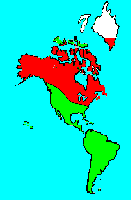SPECIES INFO
Legionnaires disease was discovered in 1976 after a convention in Philadelphia caused the unexplained deaths of 29 legionnaires. Since then the aerobic Legionella pneumophilia was discovered, and tied to the disease. This bacteria can become airborne in droplets and be inhaled.Legionella genus of bacteria was discovered in about 1976-1977. Since that time over 20 additional species have been discovered in this genus. Many are free living in either soil or water and do not appear dangerous to mankind.
The Bergey's Manual gives us a methodology of some preliminary divisions of Bacteria. This is referred to as section (4). This group contains Gram Negative aerobic rods and socci. Diseases caused by this group include whooping cough, pneumonia, and gonorrhea.
Eubacteria, the true Bacteria, is the group that contains most of the Bacteria that impact on our daily lives. Some of the diseases caused by Bacteria are: Cholera, Lyme Disease, Strep Throat, Scarlet Fever, Typhoid, Syphilis, and Gonorrhea.
Science has only begun the task or properly organizing this group of lifeforms into a taxonomy tree. The medical profession has begun with the disease causing organisms and has worked from the bottom up. They have been using various shapes and various forms of locomotion for criteria. On the other micro-biologists have been working from the top down. The result is a large open area in the middle. Here we have arbitrarily used the Bergey system for organizing disease causing bacteria in the first several classes, and have placed the algae groups in the higher classes.
Monera phylum includes the various bacteria. These are somewhat cellular organisms, but they lack a cell nucleus. Many of these organisms cause serious illness in humans. The diseases include Botulishm, Cholera, Diptheria, Gonorrhea, Lyme Disease, Plagues, Salmonellosis, Syphilis, Tetanus, Typhoid, and TB.
Monera kingdom includes the various bacteria. These are somewhat cellular organisms, but they lack a cell nucleus. Many of these organisms cause serious illness in humans. The diseases include Botulishm, Cholera, Diptheria, Gonorrhea, Lyme Disease, Plagues, Salmonellosis, Syphilis, Tetanus, Typhoid, and TB.

